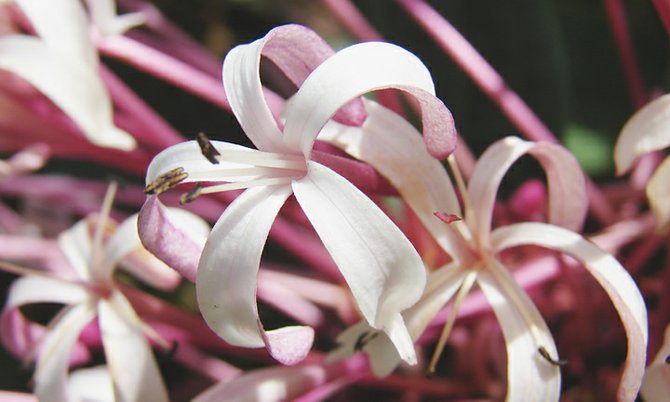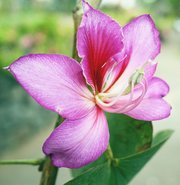The Shooting Star plant is officially known as clerodendrum quadriciloculare and gives a brief but spectacular flowering display in January and February.
A happy New Year to all Green Scene readers with the hope that 2013 will be a great year for you and your loved ones.
Although the vegetable season was set back by Hurricane Sandy, all the signs now are that it will indeed be a great year. Lettuce, peas, cucumbers and beans have already been on the menu while carrots, squash, broccoli, eggplants, sweet peppers and tomatoes are all getting close to picking time. The first ripe tomatoes should arrive later this month.
January brings bauhinias into flowering and they will be with us until past Easter. These Poor Man’s Orchid trees are a delight when flowering heavily, though the foliage tends to suffer wind damage and become unsightly.
A much briefer flowering period is experienced by clerodendrum (C. quadriloculare) but it is truly spectacular. The flowers look like exploding fireworks and are usually borne in abundance on mature plants. Clerodendrum is a handsome shrub for most of the year with long leaves that are green on top and purple beneath. Usually towards the end of January and into February the flowering begins and clerodendrum becomes the star of the garden for three or four weeks.
If your Christmas poinsettias are beginning to look a little shabby you can prune them and put them in the regular garden (or a bigger pot) to continue their growth. They will bloom again next year and in subsequent years, but will be bigger and have a greater number of blossoms.
January is a good time to plant Irish potatoes, if you have good depth of soil. It is hard to get seed potatoes in The Bahamas so we have to use store-bought potatoes that have ‘eyes’. Potatoes are tubers or swollen roots and are produced at the lower part of the stem. This means that the seed potato has to be planted five or six inches deep to allow soil to cover the new potatoes.
Cut up a potato with eyes so that you get as much potato as you can with each eye. Each eye will turn into a new plant so we only need one on each potato section. When you have enough potato sections with one eye you should dip them in a mild solution of bleach, a tablespoon of bleach to a cupful of water, and allow the sections to dry for a few days. Dig holes and then refill them to the five inch mark.
Place a potato section in the hole with the eye upwards. And barely cover it. In a few days the eye will have developed a shoot. As it grows, add a little soil every few days, though you will find that rain and regular watering will do most of the job. When the stem is well above ground, and is a viable plant, mound soil around the base.
Your potatoes will be ready to dig up when the plant dies. Use a garden fork to work underneath the potatoes from the side and then use your hands to search through the soil to make sure you find every tuber. There is no hurry to dig up potatoes once the plant has died off. Dig up your potatoes as they are
required.
We are at that time of year when just about any flowering annual will grow successfully. Now is therefore a good time to sow seeds for an Easter display. Browse through the seed packages at your local nursery and allow yourself to be adventurous.
January is also a good time to plant bulbs, tubers and rhizomes that will produce their foliage and blossoms later in the year. Once in the ground you will not have to remove the bulbs and they can become permanent members of your garden. Different bulbs have different planting depths, so follow instructions closely.
January is our coolest month so there is little activity in the fruit orchard. We are at the end of the carambola season and Indian jujube will soon be starting to ripen. Various citrus crops are now at their height or soon will be but, by and large, this is a fairly barren time of year. Many mango varieties are beginning to flower and that gives us the promise of late spring and early summer harvest.
Although insect life is not as prevalent as in the warmer months we do get some serious pests attacking our winter crops. Look out for the giant tomato hornworm, a critter that can reduce a tomato plant to shreds. Pick it off and step on it. Birds like to peck at tomatoes as they begin to redden. You may have to pick your tomatoes early and allow them to ripen off the vine. Some birds feast on tomatoes solely for the water content. If you have a dish of water or a bird bath nearby certain birds may leave your tomatoes alone.
j.hardy@coralwave.com






Comments
adele_stuart 10 years, 11 months ago
It is a good report about farming, especially how to do it in January! http://www.yachtbooker.com/Yacht-Char...">www.yachtbooker.com
midori 10 years, 10 months ago
great tips, i'll surely try that next year. http://www.acnetreatmentreviews.biz/">treatment reviews, http://cdh.ma/spe.html">see
abhiramshivakumar 10 years, 10 months ago
Happy new year for you too. The Hurricane Sandy destroyed most of the vegetation around here. A lot of farmers lost a lot of money. Now, the vegetation is getting replaced in most of the parts. But, it will take some time to revert back to the stage before Sandy. http://www.windowsonlinesupportnow.com">Windows online support now
iambala 10 years, 6 months ago
Good post and we like this since it gives great tool arrangements to supply the neat source. Thanks for the entire stuff you put on this. http://social-publicity.com/buy-youtu...">buy youtube views
iambala 10 years, 6 months ago
Back to say about the real stuff on the content. And it cool when we read other posts what they say regarding this topic. http://social-publicity.com/buy-faceb...">buy fans
Sign in to comment
Or login with:
OpenID